Family name: Potamogetonaceae Bercht. & J. Presl
Synonym(s): Zannichelliaceae Chevall., nom. cons.
Common name(s): pondweed family
*Number of genera/species: 6/110
List of genera records in GRIN-Global
fruit
Fruit a drupedrupe:
(indehiscent drupe) a fleshy, indehiscent fruit with one more hard pits enclosing seeds, derived from single, superior, simple or compound ovary; (dehiscent drupe) a fruit with a dry or fibrous to fleshy or leathery outer husk that early to tardily breaks apart (or opens), exposing one or more nutlike pits enclosing the seeds , rarely an acheneachene:
, rarely an acheneachene:
a dry, indehiscent, one-seeded fruit, with seed attached to pericarp at a single point, derived from a single, superior, simple or compound, one-loculed ovary or berryberry:
or berryberry:
an indehiscent, fleshy fruit with one or a few to many seeds. The flesh may be homogenous throughout. Or, if the outer part is hard, firm, or leathery, referred to as an hesperidium. Septa are present in some, and the seeds may be arillate or with a fleshy testa. , simple to aggregateaggregate:
, simple to aggregateaggregate:
fruit formed from a single flower with carpels several and distinct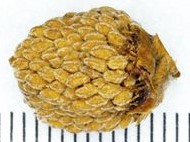 (carpels not radiating at maturity), 0.8–13 mm long, globoseglobose:
(carpels not radiating at maturity), 0.8–13 mm long, globoseglobose:
3D shape—more or less spherical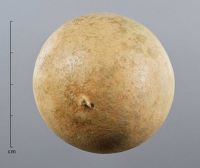 to reniformreniform:
to reniformreniform:
2D or 3D shape—kidney-shaped , tereteterete:
, tereteterete:
approximately circular in cross section; width and thickness approximately equal
 or compressedcompressed:
or compressedcompressed:
flattened; in grasses, used to denote compression (not necessarily flattened) either laterally or dorsiventrally
in transection, winged or not, stylestyle:
in a flower, the narrow and elongated part of the pistil between the stigma and the ovary; sometimes persisting in fruit persistent, often beakedbeak:
persistent, often beakedbeak:
a usually firm, terminal appendage, sometimes tapered , sometimes perianthperianth:
, sometimes perianthperianth:
collective term for calyx and corolla of a flower
 persistent, with one seed. Pericarppericarp:
persistent, with one seed. Pericarppericarp:
fruit wall or fruit coat
black, brown, green, gray, or yellow to red, dulldull:
reflecting only a low proportion of incident light, with no apparent sheen , fleshy, smooth, ridgedridged:
, fleshy, smooth, ridgedridged:
surface relief—raised, thick ridges, sharp edged or rounded, usually in a series that may cover the entire surface , keeledkeel:
, keeledkeel:
a longitudinal ridge, like the keel of a boat, formed by the lengthwise folding of a structure, such as a lemma or palea
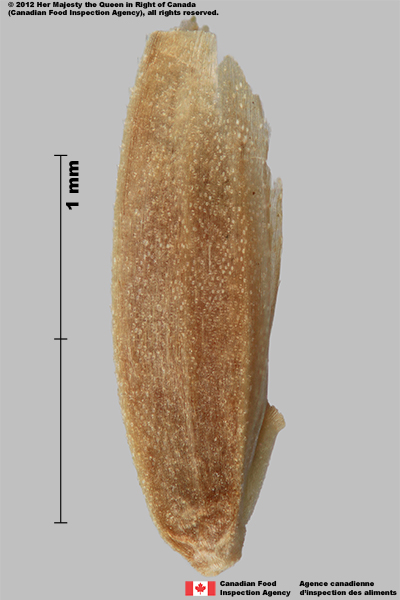 , wartywarty:
, wartywarty:
surface relief—distinct, rounded projections that are large relative to the fruit size; tuberculate, verrucose , crenulatecrenulate:
, crenulatecrenulate:
finely crenate (scalloped)
, or dentatedentate:
regularly spaced, teeth oriented more or less perpendicular to the central axis bearing them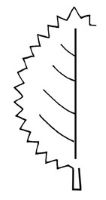 . If endocarpendocarp:
. If endocarpendocarp:
the inner layer of the pericarp, if divided into layers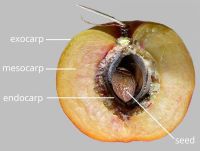 present, then operculumoperculum:
present, then operculumoperculum:
a dehiscent cap (or lid) of a seed or fruit that opens during germination or dehiscence may be present.
may be present.
Seeds oblongoblong:
2D shape—much longer than broad with nearly parallel sides, corners are rounded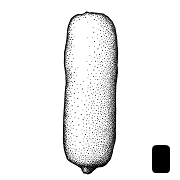 or globoseglobose:
or globoseglobose:
3D shape—more or less spherical , compressedcompressed:
, compressedcompressed:
flattened; in grasses, used to denote compression (not necessarily flattened) either laterally or dorsiventrally
in transection, minute or to 0.5 mm long. Seed coat brown, membranousmembranous:
texture—extremely thin, pliable, and fairly tough
.
Embryo well developed, macropodousmacropodous:
an embryo having an enlarged or elongated hypocotyl
, linearlinear:
(shape) long, narrow, and uniform in width; (of embryo) embryo is straight and much longer than wide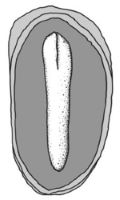 , usually coiledcoiled:
, usually coiledcoiled:
(of embryo) linear embryo is very long and bent to form a coil whereby one end of the embryo is on the outside and the other end near the middle of the seed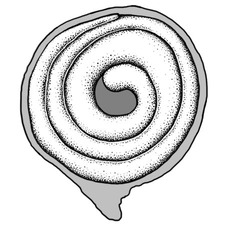 , fills seed coat, sometimes cotyledons circinately coiledcoiled:
, fills seed coat, sometimes cotyledons circinately coiledcoiled:
(of embryo) linear embryo is very long and bent to form a coil whereby one end of the embryo is on the outside and the other end near the middle of the seed .
.
Endosperm absent.
| Fruit | |
| Type | drupedrupe: (indehiscent drupe) a fleshy, indehiscent fruit with one more hard pits enclosing seeds, derived from single, superior, simple or compound ovary; (dehiscent drupe) a fruit with a dry or fibrous to fleshy or leathery outer husk that early to tardily breaks apart (or opens), exposing one or more nutlike pits enclosing the seeds  , acheneachene: , acheneachene:a dry, indehiscent, one-seeded fruit, with seed attached to pericarp at a single point, derived from a single, superior, simple or compound, one-loculed ovary  , berryberry: , berryberry:an indehiscent, fleshy fruit with one or a few to many seeds. The flesh may be homogenous throughout. Or, if the outer part is hard, firm, or leathery, referred to as an hesperidium. Septa are present in some, and the seeds may be arillate or with a fleshy testa.  |
| Size range | 0.8–13 mm long |
| Shape(s) | globoseglobose: 3D shape—more or less spherical  , reniformreniform: , reniformreniform:2D or 3D shape—kidney-shaped  , conicalconical: , conicalconical:3D shape—cone-shaped, with the point of attachment at the broad end 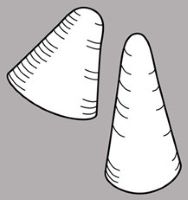 , cylindricalcylindrical: , cylindricalcylindrical:3D shape—a cylinder, with parallel sides and a circular cross-section; tubular or rod-shaped , oblongoblong: 2D shape—much longer than broad with nearly parallel sides, corners are rounded  |
| Texture | fleshy |
| Surface relief | smooth, ridgedridged: surface relief—raised, thick ridges, sharp edged or rounded, usually in a series that may cover the entire surface  , keeledkeel: , keeledkeel:a longitudinal ridge, like the keel of a boat, formed by the lengthwise folding of a structure, such as a lemma or palea  , wartywarty: , wartywarty:surface relief—distinct, rounded projections that are large relative to the fruit size; tuberculate, verrucose  , crenulatecrenulate: , crenulatecrenulate:finely crenate (scalloped) , dentatedentate: regularly spaced, teeth oriented more or less perpendicular to the central axis bearing them  |
| Color(s) | black, brown, green, gray, yellow to red |
| Unique features | Small fleshy, beakedbeak: a usually firm, terminal appendage, sometimes tapered  drupes with minute or small seeds with coiledcoiled: drupes with minute or small seeds with coiledcoiled:(of embryo) linear embryo is very long and bent to form a coil whereby one end of the embryo is on the outside and the other end near the middle of the seed  marcopodous embryos. marcopodous embryos. |
| Seed | |
| Size range | minute or to 0.5 mm long |
| Shape(s) | oblongoblong: 2D shape—much longer than broad with nearly parallel sides, corners are rounded  , globoseglobose: , globoseglobose:3D shape—more or less spherical  |
| Color(s) | brown |
| Unique features | Minute or small, brown, oblongoblong: 2D shape—much longer than broad with nearly parallel sides, corners are rounded  to globoseglobose: to globoseglobose:3D shape—more or less spherical  seeds with well-developed, usually coiledcoiled: seeds with well-developed, usually coiledcoiled:(of embryo) linear embryo is very long and bent to form a coil whereby one end of the embryo is on the outside and the other end near the middle of the seed  , macropodousmacropodous: , macropodousmacropodous:an embryo having an enlarged or elongated hypocotyl embryos. |
| Other | |
| Embryo | well developed, macropodousmacropodous: an embryo having an enlarged or elongated hypocotyl , linearlinear: (shape) long, narrow, and uniform in width; (of embryo) embryo is straight and much longer than wide  , usually coiledcoiled: , usually coiledcoiled:(of embryo) linear embryo is very long and bent to form a coil whereby one end of the embryo is on the outside and the other end near the middle of the seed  , fills seed coat, sometimes cotyledons circinately coiledcoiled: , fills seed coat, sometimes cotyledons circinately coiledcoiled:(of embryo) linear embryo is very long and bent to form a coil whereby one end of the embryo is on the outside and the other end near the middle of the seed  |
| Nutritive tissue | endosperm absent |
Worldwide.

Distribution map courtesy of Angiosperm Phylogeny Website.
Baskin and Baskin 2021Baskin and Baskin 2021:
Baskin C and Baskin J. 2021. Relationship of the lateral embryo (in grasses) to other monocot embryos: A status up-grade. Seed Science Research 31 (3): 199-210. doi:10.1017/S0960258521000209; Bobrov and Romanov 2019Bobrov and Romanov 2019:
Bobrov AVFCH and Romanov MS. 2019. Morphogenesis of fruits and types of fruit of angiosperms. Botany Letters 166 (3): 366-399. https://doi.org/10.1080/23818107.2019.1663448; Dahlgren et al. 1985Dahlgren et al. 1985:
Dahlgren RMT, Clifford HT, and Yeo PF. 1985. The families of the monocotyledons: structure, evolution, and taxonomy. Springer-Verlag, Berlin. 520 pp.; Flora of Australia 2021+Flora of Australia 2021+:
Flora of Australia. Australian Biological Resources Study, Canberra. Accessed January 2021–March 2024. URL: http://www.ausflora.org.au; Flora of North America Editorial Committee 1993+Flora of North America Editorial Committee 1993+:
Flora of North America Editorial Committee, eds. 1993+. Flora of North America North of Mexico [Online]. 22+ vols. Flora of North America Association, New York and Oxford. Accessed January-March 2024. URL: http://beta.floranorthamerica.org.; Kirkbride et al. 2006Kirkbride et al. 2006:
Kirkbride JH, Jr, Gunn CR, and Dallwitz MJ. 2006. Family guide for fruits and seeds, vers. 1.0. Accessed September 2020-January 2022. URL: https://nt.ars-grin.gov/seedsfruits/keys/frsdfam/index.cfm .; Kubitzki et al. 1990+Kubitzki et al. 1990+:
Kubitzki K et al., eds. 1990+. The families and genera of vascular plants. 7+ vols. Berlin etc.; Le and Xu 2017Le and Xu 2017:
Le C and Xu Z. 2017. Identication and control of common weeds: Volume 3. Springer Nature, Singapore. 944 pp.; Tutin et al. 1964–1980Tutin et al. 1964–1980:
Tutin TG, Burges NA, Chater AO, Edmondson JR, Heywood VH, Moore DM, Valentine DH, Walters SM, and Webb DA (eds.) 1964–1980. Flora Europaea. 5 vols. Cambridge University Press, Cambridge UK. 2,524 pp.; Watson and Dallwitz 1992+Watson and Dallwitz 1992+:
Watson L and Dallwitz MJ. 1992+. The families of flowering plants: descriptions, illustrations, identification, and information retrieval. Version: 6th Accessed September 2020-September 2022. URL: delta-intkey.com
*The number of genera and species is based on Christenhusz and Byng 2016Christenhusz and Byng 2016:
Christenhusz MJM and Byng JW. 2016. The number of known plant species in the world and its annual increase. Phytotaxa 261 (3): 201-217. https://doi.org/10.11646/phytotaxa.261.3.1, which may differ from the number of genera in GRIN-Global.